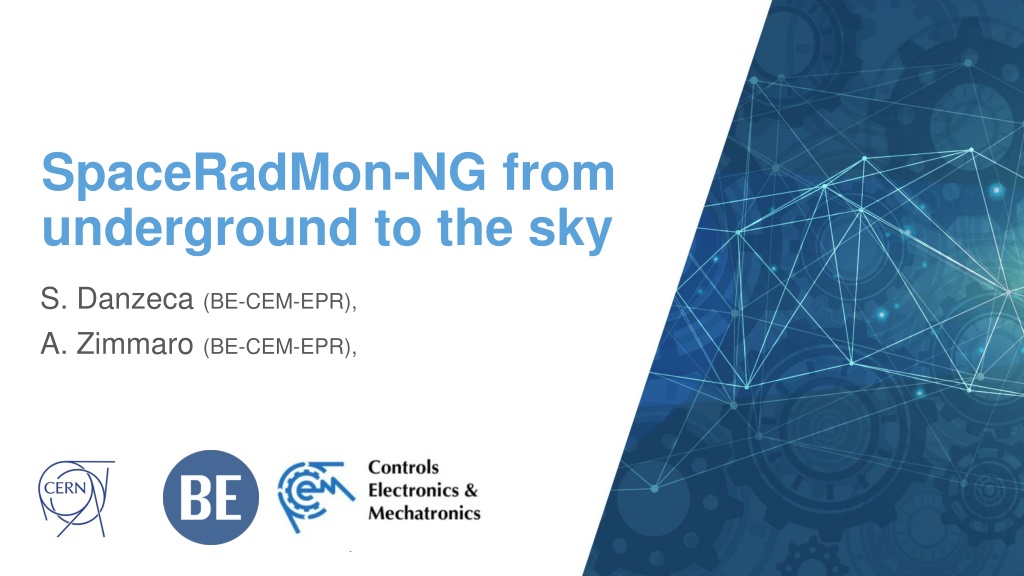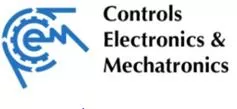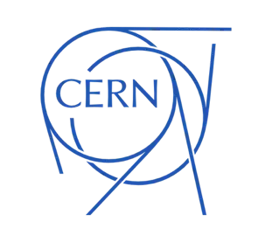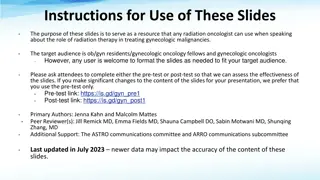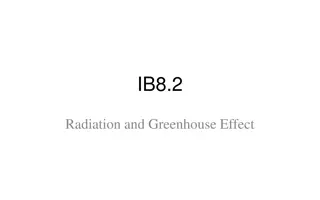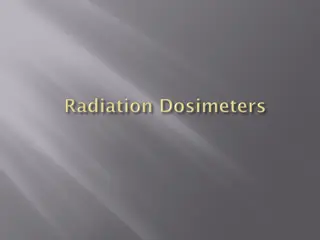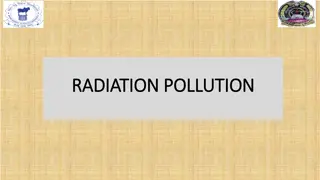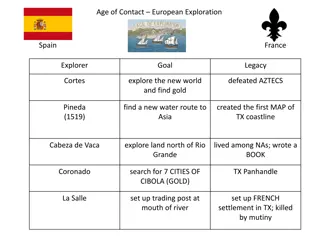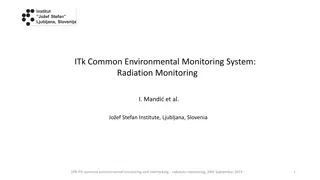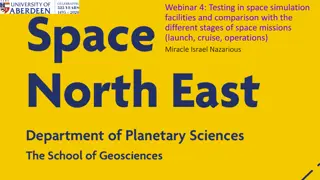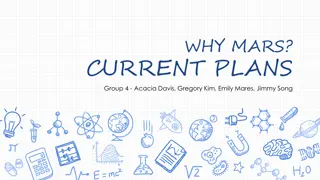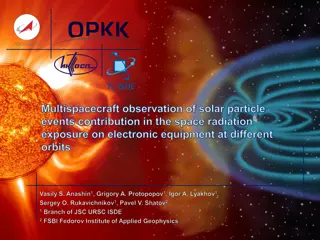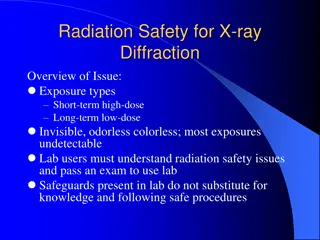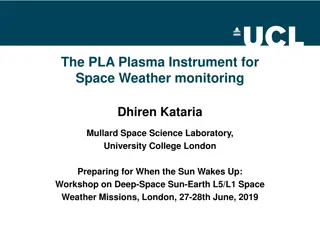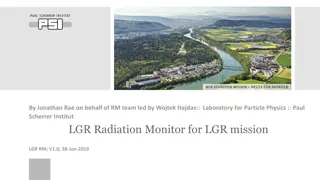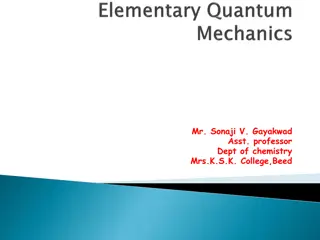SpaceRadMon-NG: Revolutionizing Radiation Monitoring in Space Missions
The SpaceRadMon-NG is a cutting-edge radiation monitoring device designed for CubeSats, offering advanced capabilities for measuring Total Ionizing Dose (TID) and High Energy Hadrons (HEHs) fluence. Developed as a next-generation solution, it aims to enhance diagnostic and environmental monitoring in space missions. Funded by KT and featuring innovative improvements like enhanced radiation tolerance and better sensor resolution, SpaceRadMon-NG represents a significant leap in space payload technology. With successful missions like CELESTA and TRISAT-R already in orbit, this platform is set to reshape how we monitor radiation in outer space.
Download Presentation

Please find below an Image/Link to download the presentation.
The content on the website is provided AS IS for your information and personal use only. It may not be sold, licensed, or shared on other websites without obtaining consent from the author. Download presentation by click this link. If you encounter any issues during the download, it is possible that the publisher has removed the file from their server.
E N D
Presentation Transcript
SpaceRadMon-NG from underground to the sky S. Danzeca (BE-CEM-EPR), A. Zimmaro (BE-CEM-EPR),
Outline What is SpaceRadMon History, versions and improvements Qualification process Space missions Conclusions 25/09/2023 SpaceRadMon NG - NASA presentation 2
SpaceRadMon SpaceRadMon is a Radiation Monitor device designed for CubeSats It was developed with knowledge/experience from RADMON - board used for radiation monitoring in the harsh environment of LHC Measures the TID and HEHs fluence Diagnostic and environmental monitoring Attractive solution for space missions RadMon 25/09/2023 SpaceRadMon NG - NASA presentation 3
SpacePayloads timeline Space RadMon NG These features make it the first example of a new generation of payloads for radiation monitoring in space, making it attractive for a larger number of missions. Funded by KT 2015 2020 CELESTA CErn Latchup Experiment and STudent sAtellite The first CERN driven 1U satellite Collaboration of CERN and CSU Challenges Low power More radiation tolerant Better sensor resolution Space RadMon V2 While CELESTA was developed for a specific mission, SpaceRadMon is intended to be a platform that can be used by multiple customers. Funded by KT SRAM Latch-up Experiment: Compare radiation levels between equator and poles Comparison of radiation effects between LEO space environment and CHARM 2018 Nanosatellites radiation qualification procedure at CHARM 25/09/2023 SpaceRadMon NG - NASA presentation 4
Mission already in orbit: CELESTA and TRISAT-R CELESTA TriSAT-R CERN tech in space: the first CERN-driven satellites have been successfully launched in 2022 orbiting at ~6000km CELESTA (1U cubesat) in collaboration with University of Montpellier: CELESTA Payload TriSAT-R (3U cubesat) in collaboration with University of Maribor: SpaceRadMon V2 payload 25/09/2023 SpaceRadMon NG - NASA presentation 5
SpaceRadMon NG 1. More radiation tolerant ADC was replaced by a MCU with embedded ADC 2. Better resolution Floating gate dosimeter instead of RadFET 3. Lowest current consumption Microsemi ProASIC3L FPGA with Flash-Freeze functionality (sleep mode - no clocks active) 4. I2C interface now compatible with PC104 SpaceRadmon NG 25/09/2023 SpaceRadMon NG - NASA presentation 6
SpaceRadMon V2 vs NG What we succeeded: Characteristics V2 NG Tolerance 250 Gy 165 mW 60 g > 418 Gy Power consumption Mass 63.5 mW Idle - 45.0 mW Sleep 57.5 g TID Sensor Resolution (TID) SRAMs Voltage monitoring Radiation Field Effect Transistor 57 mGy 1 SEU and 2 SEL No Floating Gate Dosimeter 2 mGy 2 SEUs Yes Temperature monitoring Communication protocol Yes I2C Yes I2C 25/09/2023 SpaceRadMon NG - NASA presentation 7
Floating gate working principle Target current Iout Iout Ionizing Radiation Threshold current Total Ionizing Dose SiO2 SiO2 Si p-type Si p-type 25/09/2023 05/04/2024 SpaceRadMon NG - NASA presentation 8
The Floating Gate Dosimeter (FGDOS) It is developed to measure Ionizing Radiation (TID) Radiation sensor integrated in a System-On-Chip Easy integration in more complex systems Linear radiation response High Sensitivity (resolution < 2 mGy) Works in mixed radiation field environment Resolution [mGy] Dose Range [kGy] SENSOR BIAS RadFET 5V 57 2.3 x 30 FGDOS - 2 0.3 25/09/2023 SpaceRadMon NG - NASA presentation 9
Sensor Development An Iterative Process Results Analysis Design Test chips and prototypes provided on request FGDOS Radiation Characterization Fabrication Functional Tests A collaboration that keeps going since 2013! 25/09/2023 SpaceRadMon NG - NASA presentation 10
FGDOS in space Flying FGDOS FGDOS integrated in the CryptIC project (link) on the International Space Station Dose rate [mGy/day] 0.24 0.22 Expected Dose Rate by ESA Data processed by CERN FGDOS in TRISAT-R Measuring RADFET and FGDOS Measurements well compatible 11 25/09/2023 SpaceRadMon NG - NASA presentation 11
SpaceRadMon: Radiation Qualification PSI System ready to be used PSI Test CHARM 4 Radiation Campaigns performed at PSI allowed to test system: Test lifetime and sensitivity inducing all TID, DD, and SEE Evaluate efficiency of the mitigation schemes Using the RadMon instrument as a reference, it was possible to assess the system quality of measurement performance and verify the functioning of the burst detection algorithm. Co60 Test 1st NG prototype A first radiation campaign was performed at CO60 facility to test the whole system under only TID No SEE Hardware and firmware finalized, and radiation test can start CHARM SUCCESSFUL TEST WITH MEASUREMENTS COMPATIBLE RESPECT THE ONE OF THE REFERENCE SYSTEM LIFETIME > 418 GY NO SEFI OBSERVED July 2021 July Oct. 2021 March Nov. 2022 December 2022 2020 - 2021 25/09/2023 SpaceRadMon NG - NASA presentation 12
Conclusions The SpaceRadMon NG is a result of the knowledge/experience gained all those years in radiation monitoring Is a continuous effort to improve, characterize and qualify the system (hardware, firmware/software stability, SRAM calibration, TID/DD irradiation, data analysis) SpaceRadMon NG is an ideal tool for measuring TID and HEH fluence in harsh radiation environments It has a high sensitivity with a resolution of 2mGy Extremely low power consumption Was tested extensively and is fully qualified for space missions 25/09/2023 SpaceRadMon NG - NASA presentation 13
Thank you for your attention! 25/09/2023 SpaceRadMon NG - NASA presentation 14
FGDOS as System-on-Chip Extremely flexible system Analog Circuitry Radiation Sensitive Circuit Auto-recharge Control Embedded Charge Pump Recharge Circuit Signal Temperature Compensation Circuit Conditioning Temperature Sensitive Circuit Recharge counter Configurable for different applications Digital Circuitry Finite State Machine Active Mode Highest resolution, High data rate Autonomous Mode SPI Counter Registers Controller Low power consumption, low data rate Passive Mode Clock OUT IN No power consumption, limited dose range 25/09/2023 SpaceRadMon NG - NASA presentation 15
